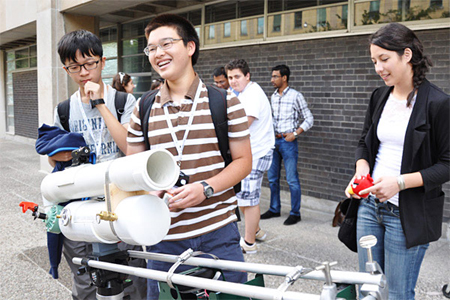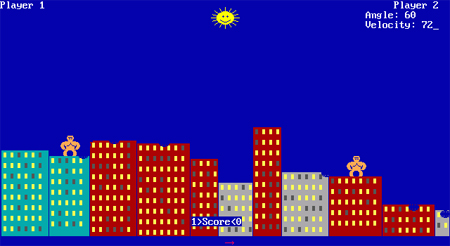Angry Birds is more than just your average mobile video game – it’s a veritable popular zeitgeist.
It’s hard to exaggerate the success of this simple game, in which birds are slingshot through the air to destroy green pigs and the structure that protect them. Rovio’s creation surpassed 1 billion downloads back in May of this year. It was already the fastest-selling video game of all time, with 50 million downloads in just 35 days after its 2009 debut. The Finnish firm that created the game, which is now a franchise of games, announced a profit – that’s money in the bank – of $62 million before taxes.

Summer camp students used a cannon to recreate Angry Birds in the real world.
So it’s no wonder that people might want to physically create a material version of Angry Birds. If causing wanton destruction with virtual birds is so enjoyable, just imagine the satisfaction of real-world carnage, right? The University of Toronto’s week-long science camp participants are the latest to embark on such a worthy endeavor.
It was more than just rigging up a big elastic band and slinging plush birds across a court yard. High school students hammered out physics equations involving arc, velocity, gravity, and wind speed. Then they loaded stuffed toys into a powered cannon and fired them at egg-stealing swine (check out the photos of the real-world Angry Birds set up).
The University of Toronto camp isn’t the first to create a real-world version of Angry Birds. Conan O’Brien did a less scientific version as a segment on his late-night talk show on TBS. In May 2011, T-Mobile rigged up a live game in Barcelona that was controllable using an Android smartphone. In Changsha, China, a theme park opened a giant-sized version of Angry Birds last year.
Angry Birds is so popular it’s been recreated on late night TV.
The real reason behind Angry Bird’s success may simply lie in the game mechanics. Its always been satisfying to estimate arc, distance, and velocity then launch something into the sky and wait to see if your aim is true. Remember Gorillas, the MS-DOS game released by IBM Corp. in 1991?

Gorillas was created by IBM as a QBasic demonstration.
Made as a demonstration of the QBasic programming language, the two-player game featured gorillas that hurled bananas at each other, until one of them finally smacked the other in the head. It challenged players to adjust the angle and velocity of each throw, and the strength of gravity.
My bet is the creators of Angry Birds played more than a few rounds.




 Brian Jackson is the Editor at ITBusiness.ca. E-mail him at
Brian Jackson is the Editor at ITBusiness.ca. E-mail him at 